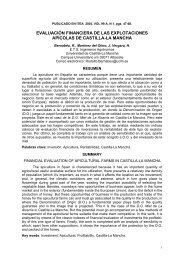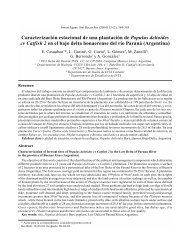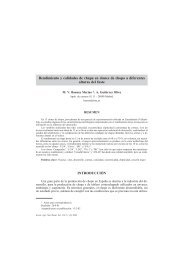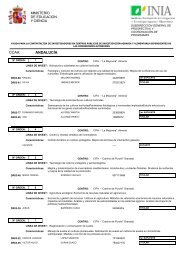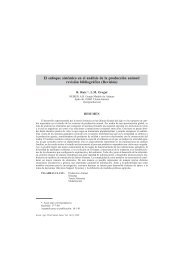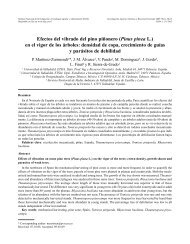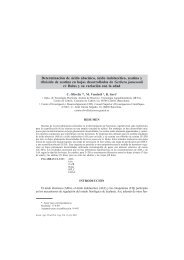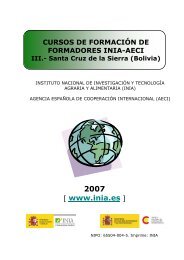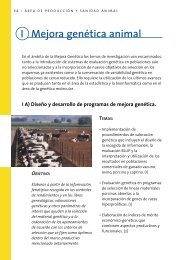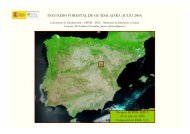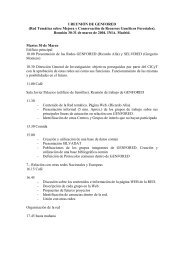Status of medicinal and aromatic plants in - Inia
Status of medicinal and aromatic plants in - Inia
Status of medicinal and aromatic plants in - Inia
You also want an ePaper? Increase the reach of your titles
YUMPU automatically turns print PDFs into web optimized ePapers that Google loves.
40<br />
WORKING GROUP ON MEDICINAL AND AROMATIC PLANTS: FIRST MEETING<br />
size <strong>of</strong> leaves, plant size, growth habit (erect/prostrate), <strong>and</strong> scent (strong/weak). These<br />
differences, particularly <strong>in</strong> flower<strong>in</strong>g time, create difficulties at harvest, result<strong>in</strong>g <strong>in</strong> yield <strong>and</strong><br />
quality loss, s<strong>in</strong>ce oregano is normally harvested at full bloom. Oregano is a cross-poll<strong>in</strong>ated<br />
species, <strong>and</strong> hence not genetically uniform. Because <strong>of</strong> its genetic heterogeneity it is possible<br />
to select better genotypes for agronomic <strong>and</strong> quality traits. Twenty-one genotypes collected<br />
from various parts <strong>of</strong> Cyprus were multiplied vegetatively <strong>and</strong> planted at Saittas <strong>in</strong><br />
replicated trials for evaluation. Seed <strong>of</strong> the best genotypes will be produced <strong>in</strong> isolation <strong>and</strong><br />
will be bulked to produce a synthetic stock. The results so far showed that there are large<br />
differences <strong>in</strong> yield <strong>and</strong> other parameters among the various genotypes tested. Total dry<br />
matter yield (leaves <strong>and</strong> flowers) dur<strong>in</strong>g the last two years (2000-2001) ranged from<br />
4190 kg/ha to 8670 kg/ha, while the oil content ranged on average from 3.3% to 5.85%.<br />
Plant population density <strong>of</strong> oregano<br />
The aim <strong>of</strong> this experiment is to determ<strong>in</strong>e the optimum population density <strong>of</strong> oregano<br />
<strong>plants</strong>. The treatments comprised n<strong>in</strong>e comb<strong>in</strong>ations <strong>of</strong> three row spac<strong>in</strong>gs (60, 90 <strong>and</strong><br />
120 cm) <strong>and</strong> three with<strong>in</strong>-row spac<strong>in</strong>gs (30, 45 <strong>and</strong> 60 cm). Two experiments were<br />
established <strong>in</strong> spr<strong>in</strong>g 1997, one at Saittas, which lies at an altitude <strong>of</strong> approximately 600 m<br />
above sea level, <strong>and</strong> the other at Zygi, located at sea level. Dur<strong>in</strong>g the whole experimental<br />
period from 1997 to 2001 there were 8 cuts at Saittas <strong>and</strong> 6 at Zygi. The total dry matter yield<br />
(leaves <strong>and</strong> flowers) at Saittas <strong>and</strong> Zygi was 22 100 kg/ha <strong>and</strong> 9000 kg/ha, respectively. The<br />
highest yield at Zygi dur<strong>in</strong>g the experimental period was obta<strong>in</strong>ed from <strong>plants</strong> spaced<br />
60 x 30 cm giv<strong>in</strong>g 5.5 <strong>plants</strong>/m 2 (10900 kg/ha) <strong>and</strong> the lowest from <strong>plants</strong> spaced 90 x 60 cm<br />
giv<strong>in</strong>g 1.8 <strong>plants</strong>/m 2 (7450 kg/ha), SE ± 727.0. At Saittas there were also significant<br />
differences among treatments <strong>in</strong> the first three years, with the plant density <strong>of</strong> 5.5/m 2 be<strong>in</strong>g<br />
the best <strong>in</strong> 1997, while the 3.7/m 2 was best <strong>in</strong> 1998 <strong>and</strong> 1999. Thereafter, differences<br />
disappeared because the <strong>plants</strong> grew large enough to cover the whole plot area.<br />
Effect <strong>of</strong> cutt<strong>in</strong>g height on the yield <strong>of</strong> oregano<br />
Height <strong>of</strong> cut is important for yield <strong>and</strong> persistence. A tall stubble leaves a photosynthetic<br />
area that provides additional carbohydrates for regrowth after cutt<strong>in</strong>g. Also, by adjust<strong>in</strong>g<br />
the cutt<strong>in</strong>g height it may be possible to get more cuts per year. Three cutt<strong>in</strong>g heights, 8, 13,<br />
<strong>and</strong> 18 cm from the soil surface were tested. Two experiments were established <strong>in</strong> spr<strong>in</strong>g<br />
1997, one at Saittas <strong>and</strong> the other at Zygi. Dur<strong>in</strong>g the whole experimental period from 1997<br />
to 2001 there were 8 cuts at Saittas <strong>and</strong> 6 at Zygi. The total dry matter yield <strong>of</strong> leaves <strong>and</strong><br />
flowers over the experimental period at Saittas <strong>and</strong> Zygi was 24330 kg/ha <strong>and</strong> 10100 kg/ha,<br />
respectively.<br />
Cutt<strong>in</strong>g at a height <strong>of</strong> 18 cm from the soil surface at Saittas produced the highest yield,<br />
26 500 kg/ha whilst a height <strong>of</strong> 8 cm gave the lowest, 22 300 kg/ha. Cutt<strong>in</strong>g at 13 cm was<br />
<strong>in</strong>termediate. At Zygi there were no significant differences among the three cutt<strong>in</strong>g heights.<br />
Control <strong>of</strong> weeds<br />
Weeds are a serious problem <strong>in</strong> <strong>aromatic</strong> <strong>and</strong> <strong>medic<strong>in</strong>al</strong> crops especially where the crop is<br />
irrigated. In a series <strong>of</strong> prelim<strong>in</strong>ary experiments <strong>in</strong>itiated <strong>in</strong> 1996 at the Agricultural<br />
Research Institute several pre-emergence herbicides were screened for their suitability <strong>and</strong><br />
effectiveness <strong>in</strong> 15 <strong>aromatic</strong> plant species, i.e. Foeniculum vulgare, Hyssopus <strong>of</strong>fic<strong>in</strong>alis, Laurus<br />
nobilis, Lav<strong>and</strong>ula angustifolia, Melissa <strong>of</strong>fic<strong>in</strong>alis, Mentha piperita, M. viridis, Ocimum basilicum,<br />
Origanum dictamus, O. dubium, O. majorana, Rosmar<strong>in</strong>us <strong>of</strong>fic<strong>in</strong>alis, Salvia fruticosa, Sideritis<br />
scardica <strong>and</strong> Thymus vulgaris. The herbicides selected were further tested <strong>in</strong> field trials. Trials<br />
that started <strong>in</strong> autumn 1996 with Lav<strong>and</strong>ula, Salvia <strong>and</strong> Origanum, were completed <strong>in</strong> 1998.<br />
The results showed that among the residual herbicides tested, chlorthal dimethyl, oxadiazon




